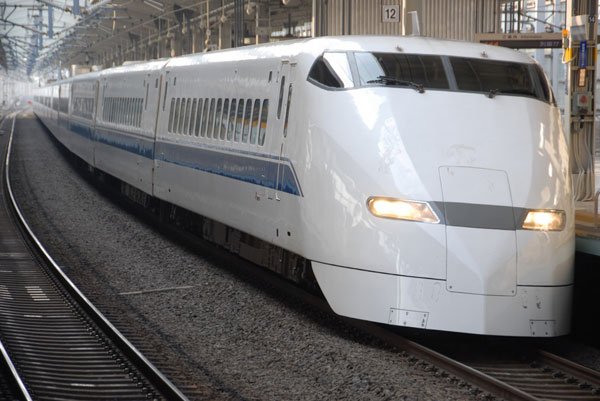Councilmembers are walking a high-speed rail tightrope, playing
their cards carefully in hopes to squeeze some extra cash from the
High Speed Rail Authority, while appeasing a growing number of
residents who believe the Council isn’t standing up for Gilroy’s
interests.
Councilmembers are walking a high-speed rail tightrope, playing their cards carefully in hopes to squeeze some extra cash from the High Speed Rail Authority, while appeasing a growing number of residents who believe the Council isn’t standing up for Gilroy’s interests.
“We have to keep negotiating,” Gilroy City Councilman Perry Woodward said, “if we give our heels in and become a thorn in their side, then we’re not likely to get consideration, input or funding to assist us in analyzing and considering the project. We’ll have a train rail … and nowhere to go.”
Expected to begin full operation in 2020, the $45-billion, 800-mile system is slated to have routes from Sacramento to San Diego with connections to the Bay Area and a major stop in Gilroy. Passengers will be transported at speeds of up to 220 mph. HSRA has narrowed the options for the rail line running through Gilroy. It will either be aligning with the current Union Pacific tracks and run through the downtown corridor or cut through the rural area east of U.S. 101. A combination of the two routes is also possible.
More and more residents have expressed frustration with the lack of information being provided by HSRA representatives at City Council meetings and more protests were expected at Monday night’s special study session scheduled to include a briefing and a breakdown of what the city has been doing, all the different meetings the High Speed Rail regional task force has attended and the letters and monetary requests sent by Gilroy and Morgan Hill to the High Speed Rail Authority, said Mayor Al Pinheiro.
“Our leverage is to be in communication, to deliberate, to highlight the impacts and show that we will not just sit back and let things happen,” said Pinheiro. “There is no question that they have the last say, but if they don’t listen and we have to go to the next step, we’ll do it,” he said, referring to the distant possibility of a lawsuit. “And if so, they’re going to hear from us even louder.”
The regional task force has existed for a year and a half. Pinheiro, Woodward and Gilroy City Administrator Tom Haglund, as well as Morgan Hill representatives – Councilman Greg Sellers, Mayor Steve Tate, and City Manager Ed Tewes – have been lobbying Rod Diridon, who is on the High Speed Rail board and Sen. Joe Simitian (D-Palo Alto), who is involved in the planning.
For Gilroy, the planning aspect could require an entirely revamped city General Plan, the overreaching document that forms the long-term blueprint for city development.
Increased traffic will mean wider roads and altered traffic patterns, plus there’s a 6,000-space parking garage that the HSRA expects Gilroy to build.
“Right now there’s no explanation of where the money will come from. I sure hope it doesn’t have to come from the reserves,” he said referencing the money Gilroy holds back from expenditures for emergency situations.
The regional task force has asked for $1 million to fund consultants to help the city analyze the information provided by the authority, and is waiting on Sacramento to pass the tardy state budget for a response.
None of the $9.9 billion in bond money approved by voters in the November 2008 election is headed Gilroy’s way for planning or building purposes.
“We have asked the High Speed Rail commission to provide us some funding,” said Woodward, “they’ve provided funding for cities before,” he said, referring to a group of Southern California cities which received approximately $800,000 to fund consultants.
Haglund punctuated the fact. “We have been very pointed in our comments with High Speed Rail that they should identify the full cost of the HSR system and they should not expect cities like Gilroy to pay.”
Against the backdrop of a state grappling with an $20 billion deficit which is struggling to pass this year’s budget, is it likely for Gilroy to receive any money?
“I understand that our request is a little hamstrung by the lack of state budget, but there will be money down the road and we’ll continue to press for that,” said Woodward.
Councilwoman Cat Tucker and Councilman Bob Dillon have a different view. Tucker would prefer the bullet train to bypass Gilroy altogether. Dillon said in August he’d rather have his teeth pulled out with no anesthesia than support the project.
Cities up the peninsula have joined together in opposition to the project. Menlo Park, Atherton and Palo Alto are suing the HSRA in hopes of stopping the project.
Haglund acknowledges many would like the City Council to take a tougher stance against the HSRA, but maintains since the city does not have the final say, the best option is for Gilroy to try to influence the HSRA rather than assume an aggressive stance.
Woodward agreed. “We don’t have the political muscle of the peninsula,” he said. “We’re not in the position to fund major litigation against high speed rail at this point.”
Woodward said if Gilroy were to dig into its pockets, it wouldn’t do any good because Menlo Park and Atherton are only stalling the inevitable.
Opting not to pursue litigation doesn’t mean public comment isn’t necessary, however,
“I think high speed rail is already starting to realize that if they don’t engage the city in a reasonable discussion, it will turn into adversarial discussion,” Woodward said.
If Gilroy is to voice their concerns and opinions on where the tracks should run, there has to be unity in the council, Pinheiro said.
“I hope that when we have all the ‘i’s’ dotted and ‘t’s’ crossed, there are not enough members in the council that say they don’t want the high speed rail, period,” he said. “We have to adhere to what our citizens voted,” giving a nod to the passage of the 2008 bond measure.
When asked how Gilroy would pay the related costs of the high speed rail if the authority decided not to fund it, Haglund said the city does not have to pay for anything it doesn’t want to.
While the HSRA has the final say, Haglund said Gilroy should expect a formal response to the 35 comments the city sent them in April on the Environmental Impact Report in November.
“The leverage that the council has is that they are the directly elected representatives of 52,000 residents and, hopefully, that speaks to a nonelected HSR authority board,” Haglund said.














